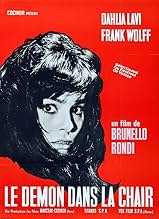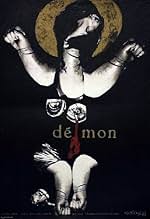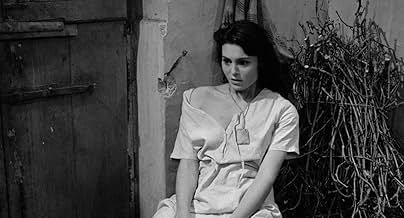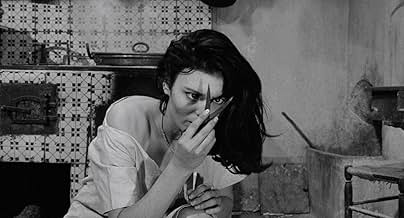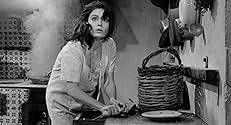VALUTAZIONE IMDb
7,2/10
1499
LA TUA VALUTAZIONE
Aggiungi una trama nella tua linguaA lonely, sexually-uninhibited young peasant is subjected to an exorcism after she hexes a man who rejects her advances.A lonely, sexually-uninhibited young peasant is subjected to an exorcism after she hexes a man who rejects her advances.A lonely, sexually-uninhibited young peasant is subjected to an exorcism after she hexes a man who rejects her advances.
- Regia
- Sceneggiatura
- Star
- Premi
- 1 vittoria e 1 candidatura in totale
Anna María Aveta
- Sister Angela
- (as Anna Maria Aveta)
María Teresa Orsini
- Nun
- (as Maria Teresa Orsini)
Luciana Angiolillo
- La Signora di Craco
- (non citato nei titoli originali)
Andrea Bosic
- Priest
- (non citato nei titoli originali)
Nino Castelnuovo
- Buca
- (non citato nei titoli originali)
Giovanni Cristofanelli
- Padre Tommaso
- (non citato nei titoli originali)
Laura Nucci
- La Madre di Purif
- (non citato nei titoli originali)
Nicola Tagliacozzo
- Zio Giuseppe
- (non citato nei titoli originali)
Recensioni in evidenza
I have to admit that I have never watched someone throw a dead cat at someone else in a film before. I'm not sure if the dead cat was a metaphor for something or other, because The Demon struck me as one of those horror films that has one foot stuck in the Art-house, so everything may just represent something else.
What I gathered from the film is that the populace of rural Italy are a very superstitious bunch who are not very good at coping when one of their own exhibits the signs of severe mental illness. I'm guessing these days if someone had walked in on young Purif piercing her chest with a needle, gathering the blood in cotton, then burning it, then giving it to a young man to drink in some wine, they may have called in a Doctor rather than accuse her of being a witch.
The young man in question is Antonio (Wolff) and he is due to marry a more stable girl, much to Purif's dismay. Purif doesn't do herself any favours however by giving Antonio the wine, watches him drink it, then shouts something like "Ha! You're drinking my blood!" It may surprise you that Antonio goes ahead with the wedding anyway.
The director here goes out of his way to show that the people in this village have just as many strange routines as Purif, from hiding a blessed scythe under Antonio's wedding bed, or shouting at an oncoming storm to break and feed the crops with rain. Not a lot goes right for these folks and naturally they begin blaming the wild eyed girl who goes around saying she has a demon inside her.
I guess the question is: Does Purif have a demon in her? Antonio wakes up covered in boils, the candles in the church start burning low, a boy is found drowned and the last person to see him was Purif. I'd probably know the answer but the only word I understood during the final narrative was the word 'free'.
This is a good film that leaves it up to you to decide if it's a horror or not. There's plenty of scenes that must have shocked way back then (Purif's raped twice by dirty old men, she does a crazy spider walk while being exorcised, also tries to strangle a nun), so I'm not sure why this one is so obscure.
What I gathered from the film is that the populace of rural Italy are a very superstitious bunch who are not very good at coping when one of their own exhibits the signs of severe mental illness. I'm guessing these days if someone had walked in on young Purif piercing her chest with a needle, gathering the blood in cotton, then burning it, then giving it to a young man to drink in some wine, they may have called in a Doctor rather than accuse her of being a witch.
The young man in question is Antonio (Wolff) and he is due to marry a more stable girl, much to Purif's dismay. Purif doesn't do herself any favours however by giving Antonio the wine, watches him drink it, then shouts something like "Ha! You're drinking my blood!" It may surprise you that Antonio goes ahead with the wedding anyway.
The director here goes out of his way to show that the people in this village have just as many strange routines as Purif, from hiding a blessed scythe under Antonio's wedding bed, or shouting at an oncoming storm to break and feed the crops with rain. Not a lot goes right for these folks and naturally they begin blaming the wild eyed girl who goes around saying she has a demon inside her.
I guess the question is: Does Purif have a demon in her? Antonio wakes up covered in boils, the candles in the church start burning low, a boy is found drowned and the last person to see him was Purif. I'd probably know the answer but the only word I understood during the final narrative was the word 'free'.
This is a good film that leaves it up to you to decide if it's a horror or not. There's plenty of scenes that must have shocked way back then (Purif's raped twice by dirty old men, she does a crazy spider walk while being exorcised, also tries to strangle a nun), so I'm not sure why this one is so obscure.
Daliah Lavi plays Purificazione,a young woman who after having her amorous advances rejected by young man in her town resorts to witchcraft to try and win him over.When the townsfolk realise what she is doing everything untoward that happens is blamed on her.Soon they have her pegged as being possessed by a demon and an exorcism is carried out in the local church..."The Demon" by Brunello Rondi is an overlooked Italian horror film from early 60's with excellent central performance of Dalilah Lavi.The infamous 'spider walk' across the church floor scene obviously inspired William Peter Blatty's "The Exorcist".The climax is tragic and unforgettable.8 exorcists out of 10.
Barely seen, underrated and overwhelming, this is an astonishing film anticipating The Exorcist by ten years yet having within it several key elements, not least the most incredible and prolonged spider walk - in a church! The black and white photography is wonderful, the soundtrack spot on, the dialogue excellent and the central performance of the possessed one, by Daliah Lavi, is hypnotic. After the opening sequence where we see her jerk her head at a sound within the house and pass her hair across her face I feel like applauding but consider it a little premature. No worry, there is not a scene in this film that does not astound or disturb. From the wondrous performance of the aforementioned Ms Lavi, the perfectly good support, or lack of, from Frank Wolff, to the fearful villagers and the daunting landscape, this is near perfect film making.
Until I posted this review, only 8 people had reviewed Il demonio and I feel like that's a real shame that it does not get the attention of some of Bava's or Fulci's films. In fact, I don't have hard proof of this but I believe Il Demonio was Fulci's inspiration (in part) for Don't Torture a Duckling.
Il demonio is a genuinely disturbing film and there is no way that it's not a classical inspiration to later films about witches and witchcraft. Like Fucli's later film, Brunello Rondi set his film somewhere in an undeveloped area of rural Southern Italiy where superstition and ignorance prevent women from expressing themselves sexually or at all as individuals, and even in the instance of mental illness or emotional disturbance, families abuse their sick relative and authoritarian religious figures abuse and take advantage of mentally unstable people, particularly sexually abusing women and young people.
Il demonio may even be landmark for its time, i am not enough of an "expert" about film to say for sure - because it challenges the Roman Catholic Church head-on in a way that craftier arthouse flicks or more satirical horror films about Satanists or hippies did not in the 1960s.
A bleak portrait of a woman abused by her father and sexually molested by religious figures and eventually other men does serve as a mirror for Don't Torture a Duckling nearly a decade later with its theme of religious abuse and a very specific character rejected as a witch by the entire town for having mental health issues or emotional disturbance after losing her infant child.
I just wish Il demonio had been in color. One of my gripes about Don't Torture a Duckling which keeps me from rating it a 10 as a giallo is Fulci's outright derision and snobbery towards Southern Italian peasants (Fulci was born in Rome) that is illustrated by how ridiculous most of the peasants are and how oppressive BROWN is throughout the film. Maybe that's how Fulci felt, maybe he was trying to communicate oppression by lack of color, but Southern Italian culture is generally the opposite - so colorful, bold and theatrical that I really do wonder what Il demonio would have looked like in color. I bet it would have won awards.
Il demonio is a genuinely disturbing film and there is no way that it's not a classical inspiration to later films about witches and witchcraft. Like Fucli's later film, Brunello Rondi set his film somewhere in an undeveloped area of rural Southern Italiy where superstition and ignorance prevent women from expressing themselves sexually or at all as individuals, and even in the instance of mental illness or emotional disturbance, families abuse their sick relative and authoritarian religious figures abuse and take advantage of mentally unstable people, particularly sexually abusing women and young people.
Il demonio may even be landmark for its time, i am not enough of an "expert" about film to say for sure - because it challenges the Roman Catholic Church head-on in a way that craftier arthouse flicks or more satirical horror films about Satanists or hippies did not in the 1960s.
A bleak portrait of a woman abused by her father and sexually molested by religious figures and eventually other men does serve as a mirror for Don't Torture a Duckling nearly a decade later with its theme of religious abuse and a very specific character rejected as a witch by the entire town for having mental health issues or emotional disturbance after losing her infant child.
I just wish Il demonio had been in color. One of my gripes about Don't Torture a Duckling which keeps me from rating it a 10 as a giallo is Fulci's outright derision and snobbery towards Southern Italian peasants (Fulci was born in Rome) that is illustrated by how ridiculous most of the peasants are and how oppressive BROWN is throughout the film. Maybe that's how Fulci felt, maybe he was trying to communicate oppression by lack of color, but Southern Italian culture is generally the opposite - so colorful, bold and theatrical that I really do wonder what Il demonio would have looked like in color. I bet it would have won awards.
"Il demonio" follows Puri, a young peasant woman in a small Italian villa who is obsessed with Antonio, a married man. Puri's sickly fixation on Antonio leads her to practice witchcraft in an attempt to direct him to her, but instead, she becomes subject of a witch-hunt when she becomes apparently possessed.
This obscure Italian shocker predates mainstream possession film such as "The Exorcist" (by ten years!), and, while it is not as gratuitous as that film or the others in its wake, "Il demonio" is no less a powerful, artful exploration of obsession, superstition, and evil. One of its most intriguing components is that it consistently toes the line between "is it real?" and fully committing to being outright supernatural--at times, it appears that perhaps Puri is being persecuted for her zany (though ostensibly harmless and ineffective) attempts at witchcraft--at others, however, the reality of the situation is not so clear.
In either case, the character of Puri is a tragic one, as her mental illness is either misunderstood, or, perhaps, leads her to fall prey to a demonic force. Daliah Lavi's performance as Puri glues the film together, as she is both tragic and pitiful--Lavi's acting never goes too far over the edge, but it comes tantalizingly close. The film is further bolstered by its gorgeous, expressionistic imagery, with stark black-and-white photography pinning the characters against vast landscapes, at times resembling something you might see in an Ingmar Bergman feature.
The screenplay does feel a tad clunky in its final act, but its resolution brings it full circle in a befitting (albeit downbeat) manner. All in all, "Il demonio" is a powerful film that consistently leaves the audience turning it over in their heads. Ambiguity is very well utilized, and Lavi's riveting lead performance is key--be it a case of the psychological or the spiritual, "Il demonio" is potent no matter how you read it. 9/10.
This obscure Italian shocker predates mainstream possession film such as "The Exorcist" (by ten years!), and, while it is not as gratuitous as that film or the others in its wake, "Il demonio" is no less a powerful, artful exploration of obsession, superstition, and evil. One of its most intriguing components is that it consistently toes the line between "is it real?" and fully committing to being outright supernatural--at times, it appears that perhaps Puri is being persecuted for her zany (though ostensibly harmless and ineffective) attempts at witchcraft--at others, however, the reality of the situation is not so clear.
In either case, the character of Puri is a tragic one, as her mental illness is either misunderstood, or, perhaps, leads her to fall prey to a demonic force. Daliah Lavi's performance as Puri glues the film together, as she is both tragic and pitiful--Lavi's acting never goes too far over the edge, but it comes tantalizingly close. The film is further bolstered by its gorgeous, expressionistic imagery, with stark black-and-white photography pinning the characters against vast landscapes, at times resembling something you might see in an Ingmar Bergman feature.
The screenplay does feel a tad clunky in its final act, but its resolution brings it full circle in a befitting (albeit downbeat) manner. All in all, "Il demonio" is a powerful film that consistently leaves the audience turning it over in their heads. Ambiguity is very well utilized, and Lavi's riveting lead performance is key--be it a case of the psychological or the spiritual, "Il demonio" is potent no matter how you read it. 9/10.
Lo sapevi?
- QuizDaliah Lavi cited this as her favorite movie and her best performance.
- ConnessioniFeatured in Woodlands Dark and Days Bewitched: A History of Folk Horror (2021)
I più visti
Accedi per valutare e creare un elenco di titoli salvati per ottenere consigli personalizzati
- How long is Il demonio?Powered by Alexa
Dettagli
- Tempo di esecuzione1 ora 38 minuti
- Colore
- Mix di suoni
- Proporzioni
- 1.66 : 1
Contribuisci a questa pagina
Suggerisci una modifica o aggiungi i contenuti mancanti

Divario superiore
By what name was Il demonio (1963) officially released in India in English?
Rispondi
